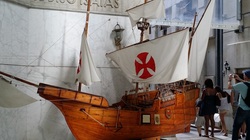
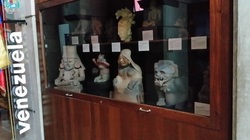
This makes this museum quite useful to students studying Pre-Columbian peoples.
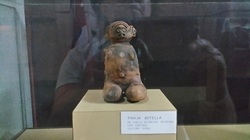
Taino artifact shown in the photograph to the left.
Artifacts from the mass by Pope John Paul II below.
| Culture with Camoluscious Gally |
|
 On my visit to the Columbus Lighthouse in Santo Domingo, Dominican Republic, I wondered what could possibly have inspired such an immense outpouring of ugly cement, but as I was introduced to the history and purpose behind the building my approval grew. The museum and memorial in honor of the 500 year anniversary of Christopher Columbus' landing in the Dominican Republic is actually a storehouse of culture dedicated to showing what life in the Americas was like in 1492. The secondary purpose, of shining a large cross into the night sky is now limited to special occasions. Read more about the history of the Columbus Lighthouse here. The interior contains models of the Nina, Pinta and Santa Maria (see photo left).  In the base of the cross are rooms storing collections of artifacts produced by the people of the American countries including this one to the left provided by Venezuela. This makes this museum quite useful to students studying Pre-Columbian peoples.  The Dominican Republic provided a number of artifacts for the collection including a box containing the purported ashes of Christopher Columbus, Taino artifacts (read about the end of the Taino's here), and from the mass celebrated by Pope John Paul II. Taino artifact shown in the photograph to the left. Artifacts from the mass by Pope John Paul II below.
0 Comments
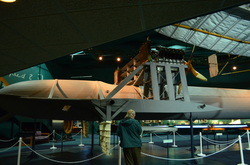 One of the thrills of visiting the Alexander Graham Bell National Historic Site in Baddeck, Nova Scotia for me was finding out that Alexander Graham Bell and Frederick Walker Baldwin had created one of the first hydrofoil vehicles, the HD4, and used it to set a world speed record in 1919. One practical application that came out of Alexander Graham Bell's research was a tetrahedral towing device used by the Navy for target practice. These were used for a number of years although they suffered from structural problems. See photograph below for an example pontoon and tetrahedral object. Although Frederick Walker Baldwin and Alexander Graham Bell's wife Mabel rode the hydrofoils, Alexander Graham Bell did not, according to t. The museum explained Alexander Graham Bell was fascinated with water striders because of their ability to move across the water. Water striders, Jesus bugs, skimmers, water skaters and water skeeters all belong to the insect family Gerridae. 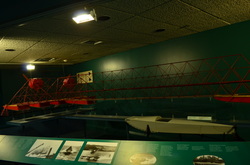 My first experience with a hydrofoil was at the Boeing Factory in Renton, WA where I worked as a decal maker. The factory sits on Lake Washington and Boeing had a dock they had used for delivery of supplies during World War II and put to use designing, building and testing their passenger Jetfoil. See here for more history about Boeing's hydrofoil work. My only exciting tale about the hydrofoil, other than the engineer that used to scare me by walking by and grabbing my neck to give me a neck massage while I worked at the punch press was the day one of the diver's got trapped and they used the small hydrofoil to rescue him. It made factory life a lot more interesting. The first hydrofoil was designed and built by Enrico Forlanini in1906 , according to the US Hydrofoil Association. |
Sheri Fresonke HarperSheri loves to golf, travel, take photographs and make new friends. Follow Sheri Fresonke Harper on Quora
Archives
July 2017
Categories
All
|